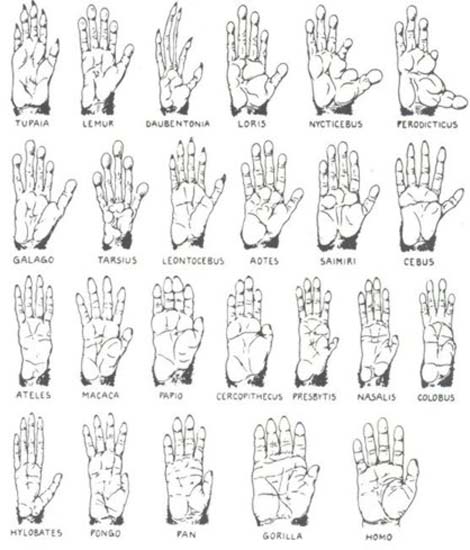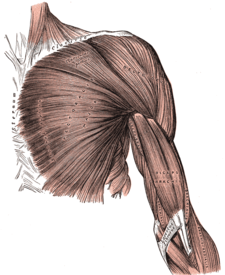(Picture from here.)
And I am back.
It’s been a rough month. I tore my biceps tendon in judo
back in October and it had to be reattached. Which meant it had to be in a cast
for a month. As keeping it in the thumbs up position is sort of counter
productive, I’ve been working on moving it back to typing position for the last
few weeks.
The biceps brachii isn’t just the big honking muscles that
bulge out during a biceps curl. That is, the biceps gets bigger when you curl
but there are a lot of other muscles that lift—notably the brachialis muscle.
In fact, one can tear the biceps pretty bad and regain most or all of the
strength of the lift.
What the biceps really does is lift and rotation. If you
bear down to turn a screw you’re using your biceps. It is intended to turn the
hand to the outside and flex the elbow. This is why the biceps curl has the hand
turned towards your face: that’s where the biceps is fully contracted. If you
curl with your hand pointing the other way, like some 19th century
boxer, the biceps can’t fully contract.
So, in the interested of making lemonade, I’m going to talk
about the evolution of the biceps most important friend, the human hand. After
all, if the main intention of the biceps is to be able to rotate the arm, what’s
the point without the hand?
First, let’s look at a hand.
Four fingers and a thumb. Hm. Well, mice have five fingers.
How far back does that go?
Let me present Protungulatum
donnae, a rat like ancestor of placental mammals from the very end of
the Cretaceous. It had five fingers.
But this isn’t so surprising since if you look at the front
claws of an iguana you see… five fingers. If you look at a salamander… five
fingers. Amphibians, reptiles, dinosaurs, birds and mammals all belong to the
superclass Tetrapoda. One
of the defining characteristics of tetrapods is the five distinct carpals. Some
may be fused as in crows and horses but many groups from rats to iguanas to
apes have the same five carpals. Hold up your hand and you see the same bones
as would a Komodo dragon lizard.
 (Both pictures from here.)
(Both pictures from here.)
But they’re not hands
like we think of hands. Monkeys have hands. Lemurs have hands. Chimps
definitely have hands.
What makes a hand? Hands have thumbs, right? Where did the
thumb come from?
It turns out that thumbs appeared in primates about 70 mya. There’s
some evidence of the beginnings of a thumb in dinosaurs but since mammals and
dinosaurs split off many millions of years ago it’s unlikely there’s any
connection.
Let’s look at the hand again. Thumb off to one side. All
fingers in the same plane with the thumb underneath.
If you look at the picture of primate hands you can see the
movement of the thumb. In lemurs it’s nearly in the same plane as the other
fingers. But by the time you look at the great apes the thumb has definitely
migrated to the front of the hand—not as much as in the human hand but there
are clear resemblances.
Now if you look at the hand of the great apes: orangutan,
chimp and bonobo, gorilla and human, there’s a definite difference between
them. First, there’s a definite reduction in the length of the fingers of the
human hands. Gorillas and baboons have an almost human looking fingerset where
the others have a different palm to finger arrangement. The thumb, again, is
strongly differentiated between the humans and the other apes. It’s more
divided away from the rest of the hand and further rotated towards the front—the
“opposable thumb” of people comes from that rotation.
Remember, though, the fundamental bone and muscle
architecture underneath is almost the same. There’s no new muscles or bones. A
radius and ulna in the human and the other great apes are very similar. They
even have a biceps for rotation. It’s very similar to the way I spoke about the
shoulder a while back. Chimp shoulders and human shoulders are very similar but
humans have eroded just a little bit so we can throw things. Chimps can’t do
that.
The evolution of the human hand from the common ancestor it
had with the other great apes has been a continuing area of discussion. For one
thing, tool use has been presented as a strong selector—which it no doubt is.
Chimps and monkeys and crows can use tools such as twigs and rocks but only
humans have managed the dexterity to make napped stone. And I don’t think it’s
just intelligence. Our ancient ancestors weren’t much smarter than chimps but
they made many more tools than they ever had. I suspect it wasn’t because they
were so much smarter. It was because of their hands.
Evolution only works on what you have. Consequently, humans
must initially had a slight advantage for tool use over other groups of apes.
Just enough that the slight advantage became an object of selection towards the
modern hand. After all, we used fire
a million years ago.
Tool use is one important selection mechanism. But are there
more?
Remember the human shoulder? It enables us to throw things.
It enables us to throw things that we can grasp in that odd pre-human hand.
There’s been a school of thought that this throwing
mechanism (See Richard Young’s article.) is
one of the primary mechanisms of evolutionary pressure. Analysis of the hand
suggests two fundamental human grips: the precision grip and the power grip. One
is for delicate operations and the other is for the application of force. The
human hand is capable of both. The chimp is not particularly capable of either
by comparison. We can nap flint and pound with a club using the same appendage.
This extends, though, into throwing things like spears or rocks—something we’re
also peculiarly adapted to in our shoulders.
William
Calvin pursues this even further in his “throwing Madonna” idea. The
interesting thing here is that if we throw a spear (or a fast ball) the signal
to turn the hand just so to release the object has to be on its way to the hand
before the shoulder throw is
complete. We can’t reach the right point and then send the message—neurons just
aren’t that fast. So the system has to plan
it and set it up in place. And we do it really well. It is his contention that
the same forces that acted on the hand acted on the brain.
Okay. We can apply power with the power grip. We can build
things with the precision grip. And we get a brain along for the ride. Why can
we make a fist?
Look at that fist. The fingers are at a right angle,
exposing the knuckle. There’s some serious bone on that knuckle—not at the
level of a gorilla knuckle walker but it’s substantial. Why would we evolve
something like that?
To punch
each other.
There are a lot of hand configurations that give us a
precision and power grip but only one that gives us a fist. That seems kind of
a rough start to things. Surely there would be other evidence if that were the
case.
There’s this thing called the human face. It’s an odd thing.
Flat in the front. Nose is recessed except for a soft bit that protrudes. High
cheekbones flush around the eyes. Turns out this makes the face tolerate a
punch much better than that old ape face. (See here.)
And it’s somewhat sex specific: men’s faces are better designed to take a hit
than women’s.
So: hands evolved for tool use, throwing and brawling and
the brain came along with it.
One wonders if the hand evolved to throw a punch maybe the
brain evolved so we didn’t have to.
Additional: Good slide show on the evolution of the human hand here.




